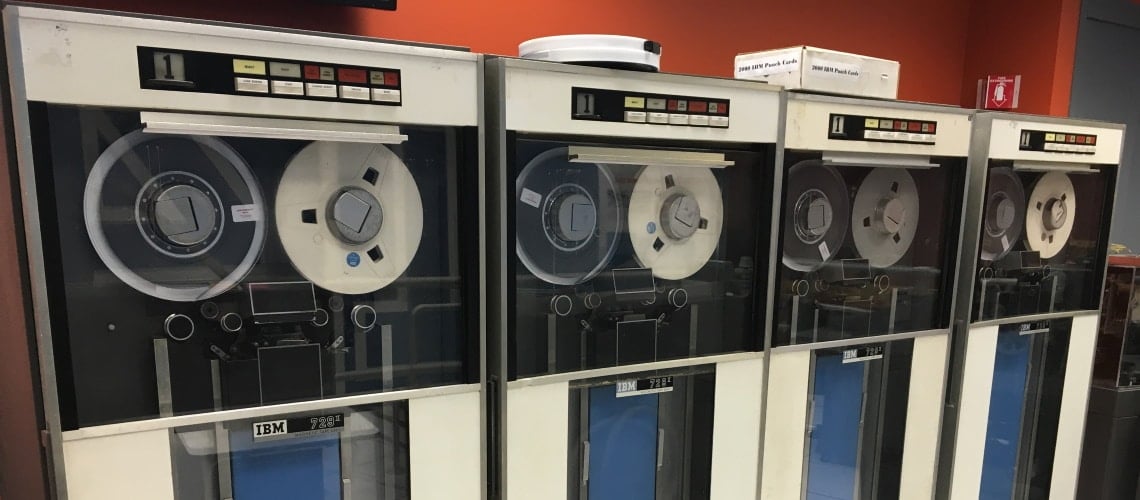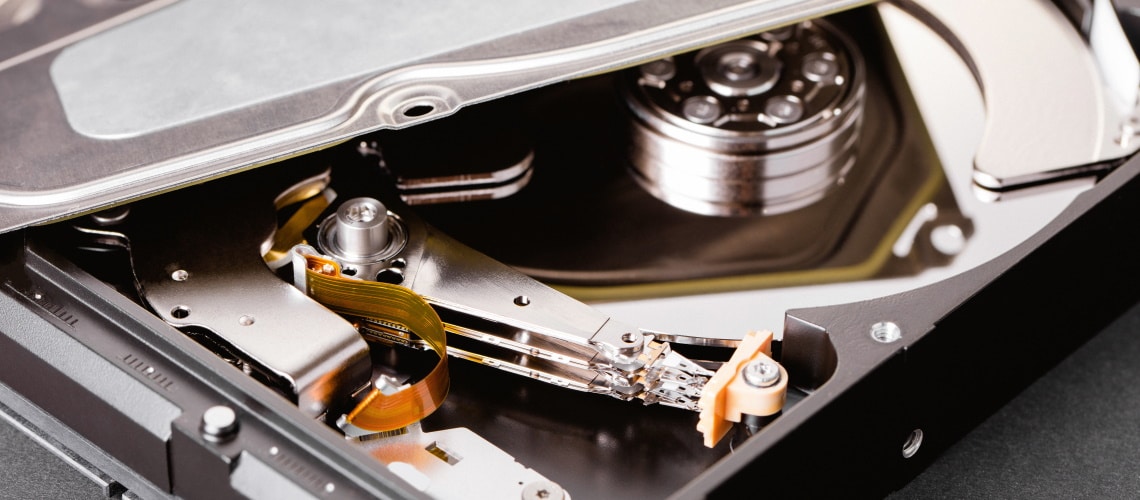A Brief History of Data Storage

Explore the evolution of data storage, from punch cards to cloud computing. Discover how past innovations shape our digital world today. Uncover the fascinating story of data storage.

Join 2000+ tech leaders
A digest from our CEO on technology, talent and hard truth. Get it straight to your inbox every two weeks.
No SPAM. Unsubscribe anytime.
Just like processor clock speeds, data storage has progressed enormously over the history of computing. Most of us remember the days when the floppy disk was still ubiquitous, however, data storage goes back far longer than that.
History of Storage Technologies Timeline
The very first data storage device came in the form of punched cards. The history of these actually dates back to 1725, when textile worker Basile Bouchon invented them for use in textile looms to define patterns and automate various manufacturing processes.
Modern data storage, however, has its roots in the late forties when the first digital data storage devices came into being. Starting from 1947, the following takes a look at the fascinating changes in a technology that most of us today take for granted.
1947 – The Williams-Kilburn Tube
 The Williams-Kilburn tube was the very first digital data storage device.
The Williams-Kilburn tube was the very first digital data storage device.
Using random access memory, the device was developed between 1946 and 1947 and became a commercial success in the earliest computers. This device could execute one instruction every 1.2 milliseconds and come in capacities of a rather limited 512 or 1024 bits (64 or 128 bytes respectively). This means that the device could theoretically store a maximum of 64 or 128 characters of the standard Latin alphabet. To put this into perspective, a one terabyte hard drive in a modem computer is 4.3 to 8.6 billion times larger.
1950 – Drum Memory
 Drum memory became the first widely used data storage device.
Drum memory became the first widely used data storage device.
Using magnetic media rather like floppy disks, these devices were actually invented by Gustav Tauschek in 1932, although they did not become widespread until the early fifties. Dram memory devices were often used alongside punched cards which loaded information on and off them as secondary storage devices. The first drum memory device had 62.5 kilobytes of memory although the ones used on the earliest mass-produced computers only had about 8.5 kilobytes. Dram memory was used right up until the mid-sixties.
1951 – The First Tape Drives
 Tape drives of a type are still used today in some cases.
Tape drives of a type are still used today in some cases.
The first one was released by the business machines manufacturer Remington Rand in 1951. The UNISERVO, as the device was called, was the commercially-available tape drive and was a component on the enormous UNIVAC I computer. These computers became popular in big companies for storing data such as customer information and contract details. The UNIVERSO could transfer data at a rate of 12,800 characters per second and boasted a capacity of 224 kilobytes. Tape drives continued to develop, eventually reaching hundreds of gigabytes in capacity. They are still in use today in various business applications.
1972 – Cassette Tapes
 Long after their invention, cassette tapes were best known for storing audio recordings.
Long after their invention, cassette tapes were best known for storing audio recordings.
However, from 1972, cassette tapes became an industry-standard data storage medium and one which was widely used on early desktop computers. Among the first desktop computers to use cassette tapes was the Hewlett Packard 9830, released in 1972. Cassette tapes had a capacity of 660 kilobytes on each side, for a total of 1320 kilobytes. Some of the most famous retro computers such as the Commodore 64 and the ZX Spectrum used cassette tapes for storing games, applications, and other software. Cassettes were the standard data storage devices used in the earliest home computers and they remained widespread until the late eighties.
1976 – Floppy Disks
 Although floppy disks had were invented in the late sixties, it was not until the release of the 5.25-inch floppy disk in 1976 that they became widespread in both the home and business computing world. Before this, floppy disks were eight inches wide and not considered suitable for contemporary desktop computers. The first 5.25 inch floppies had a capacity of just under 100 kilobytes. By 1978, double-sided disks offering 360 kilobytes of data storage became available. Throughout the seventies and into the eighties, the 5.25-inch floppy was the industry standard for data storage in word processors and computers. The next floppy disk to become popular was the 3.5 inch one, launched in 1982. These eventually reached a capacity of 1.44 megabytes and became ubiquitous in the world of computing right up until the early nineties. Only in the mid-2000s did floppy disks almost vanish entirely with most modern motherboards no longer providing support for the floppy disk interface. Floppy disks are still used in some extremely expensive industrial hardware for uploading instructions.
Although floppy disks had were invented in the late sixties, it was not until the release of the 5.25-inch floppy disk in 1976 that they became widespread in both the home and business computing world. Before this, floppy disks were eight inches wide and not considered suitable for contemporary desktop computers. The first 5.25 inch floppies had a capacity of just under 100 kilobytes. By 1978, double-sided disks offering 360 kilobytes of data storage became available. Throughout the seventies and into the eighties, the 5.25-inch floppy was the industry standard for data storage in word processors and computers. The next floppy disk to become popular was the 3.5 inch one, launched in 1982. These eventually reached a capacity of 1.44 megabytes and became ubiquitous in the world of computing right up until the early nineties. Only in the mid-2000s did floppy disks almost vanish entirely with most modern motherboards no longer providing support for the floppy disk interface. Floppy disks are still used in some extremely expensive industrial hardware for uploading instructions.
1980 – Hard Disks
 The precursor to the modern hard disk is generally considered to be the ST-506 released by Seagate in 1980. This was the first 5.25-inch hard disk (a standard hard disk size for years afterward). It had a capacity of five megabytes and came with a hefty price tag of 1,500 USD. Around the time, IBM developed the world’s first gigabyte-capacity hard drive for business users. The IBM 3380 had a capacity of 2.52 gigabytes, but it also weighed as much as a large refrigerator. It was not until the mid- to late-eighties that hard disks started to ship with modern home computers. These hard disks typically came with capacities in the tens of megabytes. By the late nineties hard disk sizes were already reaching capacities of several gigabytes, while today, they often surpass the terabyte mark.
The precursor to the modern hard disk is generally considered to be the ST-506 released by Seagate in 1980. This was the first 5.25-inch hard disk (a standard hard disk size for years afterward). It had a capacity of five megabytes and came with a hefty price tag of 1,500 USD. Around the time, IBM developed the world’s first gigabyte-capacity hard drive for business users. The IBM 3380 had a capacity of 2.52 gigabytes, but it also weighed as much as a large refrigerator. It was not until the mid- to late-eighties that hard disks started to ship with modern home computers. These hard disks typically came with capacities in the tens of megabytes. By the late nineties hard disk sizes were already reaching capacities of several gigabytes, while today, they often surpass the terabyte mark.
1982 – Optical Disks
 In 1982, Sony launched the very first CD player and within a decade, CDs became widely used as a way of storing music and as data storage devices for computers. Although they were rarely practical for writing and modifying due to technological limitations, CDs became the industry standard for software distribution. Windows 3.1 was the first version of Microsoft Windows to be released on CD (though it was also available on floppies) in 1992. Compact disks proved to be enormously useful in the computing world due to the fact that they offered 650 megabytes of storage, equivalent to around 4501.44-inch floppy disks. Although all modern optical drives still read CDs, they are very rarely used for computer data storage these days.
In 1982, Sony launched the very first CD player and within a decade, CDs became widely used as a way of storing music and as data storage devices for computers. Although they were rarely practical for writing and modifying due to technological limitations, CDs became the industry standard for software distribution. Windows 3.1 was the first version of Microsoft Windows to be released on CD (though it was also available on floppies) in 1992. Compact disks proved to be enormously useful in the computing world due to the fact that they offered 650 megabytes of storage, equivalent to around 4501.44-inch floppy disks. Although all modern optical drives still read CDs, they are very rarely used for computer data storage these days.
With capacities of 4.7 gigabytes or 8.4 gigabytes double-sided, DVDs became the industry standard in the second generation of optical data storage. Although DVDs were invented in 1995, they did not become popular until around 2001. Today, DVDs remain the standard storage medium for physical software distribution in spite of the launch of Blu-ray disks in 2006. Standard Blu-ray disks are available with capacities of 25 or 50 gigabytes, though their use has so far only proven popular for storing high-definition movies and for use with gaming consoles. The coming years will likely see the holographic versatile disk (HVD) become available to the public, offering capacities of up to 6 terabytes.
2000 – Flash Memory Drives
 Flash memory drives include memory cards commonly used in phones and cameras and USB flash drives used with computers and other devices. They use exactly the same technology; the only difference is the connectivity type. The first USB memory stick was launched in 2000 and was available in capacities of 8,16 and 32 megabytes Flash memory drives became the most popular way to share data between different devices, and this remains the case to this day. However, today’s flash memory cards and drives come with capacities of up to 128 gigabytes and are constantly getting larger every year. Another type of storage media which uses the same technology (flash memory) is solid-state drives. These are super-fast high-end drives used in desktop and laptop computers. However, they are much more expensive and only available in low capacities compared to standard hard drives.
Flash memory drives include memory cards commonly used in phones and cameras and USB flash drives used with computers and other devices. They use exactly the same technology; the only difference is the connectivity type. The first USB memory stick was launched in 2000 and was available in capacities of 8,16 and 32 megabytes Flash memory drives became the most popular way to share data between different devices, and this remains the case to this day. However, today’s flash memory cards and drives come with capacities of up to 128 gigabytes and are constantly getting larger every year. Another type of storage media which uses the same technology (flash memory) is solid-state drives. These are super-fast high-end drives used in desktop and laptop computers. However, they are much more expensive and only available in low capacities compared to standard hard drives.
Today – Cloud Storage
 Cloud storage services are nothing new, but they are rapidly becoming widespread. They also completely revolutionize data storage. Cloud storage is all about storing data online, effectively providing consumers with near-limitless storage space. From Microsoft’s OneDrive to Gmail’s generous gigabytes of free storage space, cloud storage is likely to become the next standard of data storage for both homes and businesses.
Cloud storage services are nothing new, but they are rapidly becoming widespread. They also completely revolutionize data storage. Cloud storage is all about storing data online, effectively providing consumers with near-limitless storage space. From Microsoft’s OneDrive to Gmail’s generous gigabytes of free storage space, cloud storage is likely to become the next standard of data storage for both homes and businesses.
Typical Projects You Can Build with Echo
- Web Development for Dry & Cold Storage Company
- Code Integration for Data Management Platform
- Discovery for Automated Storage & Retrieval Systems Company
- Blockchain-Based Storage Platform Dev
- Dev Outsourcing Services for Research & Data Analysis Firm



It’s hard for me to imagine that we started way back there at the Williams-Kilburn tube, now that we have phones that fit in our pockets and can store more than anyone back then could dream. And it only took four years to go from storing a hundred letters to sending 12,800 characters per second? Must have blown people’s minds back then.
This is an interesting look. I’m amazed to learn what the earliest computers used for storage and that punched cards were around since 1725!